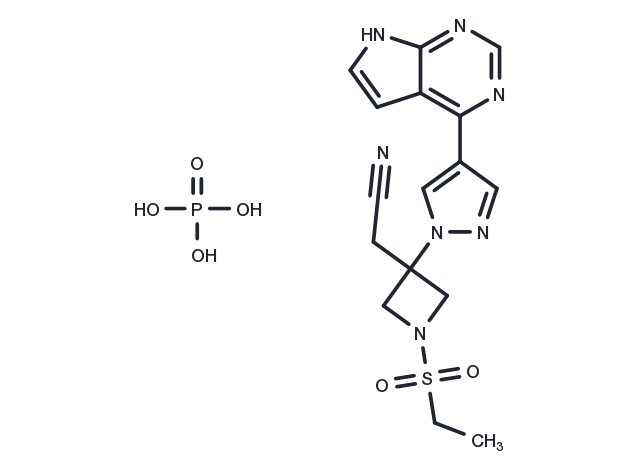Powder: -20°C for 3 years | In solvent: -80°C for 1 year


Baricitinib phosphate (INCB028050) is a selective orally bioavailable JAK1/JAK2 inhibitor.

| Pack Size | Availability | Price/USD | Quantity |
|---|---|---|---|
| 5 mg | In stock | $ 40.00 | |
| 10 mg | In stock | $ 57.00 | |
| 25 mg | In stock | $ 94.00 | |
| 50 mg | In stock | $ 117.00 | |
| 100 mg | In stock | $ 147.00 | |
| 500 mg | In stock | $ 369.00 | |
| 1 mL * 10 mM (in DMSO) | In stock | $ 50.00 |




| Description | Baricitinib phosphate (INCB028050) is a selective orally bioavailable JAK1/JAK2 inhibitor. |
| Targets&IC50 | JAK2:5.7 nM, JAK1:5.9 nM |
| In vitro | Baricitinib (INCB028050) effectively inhibits JAK signaling and function in various cell-based assays, showcasing its potent anti-inflammatory properties. In Peripheral Blood Mononuclear Cells (PBMCs), it impedes IL-6-induced phosphorylation of STAT3 (pSTAT3) and reduces MCP-1 chemokine production, with half-maximal inhibitory concentrations (IC50) of 44 nM and 40 nM, respectively. Further, in naive T-cells, Baricitinib blocks pSTAT3 activation by IL-23 with an IC50 of 20 nM, crucially preventing the release of inflammatory cytokines IL-17 and IL-22 from Th17 cells, at an IC50 of 50 nM. Unlike Baricitinib, the structurally similar JAK1/2 inhibitors INCB027753 and INCB029843 show no significant activity in these assays even at concentrations up to 10 μM[1]. |
| In vivo | Baricitinib (INCB028050) treatment significantly reduces hind paw swelling in comparison to the vehicle control, achieving a 50% reduction at a dosage of 1 mg/kg and over 95% reduction at dosages of 3 or 10 mg/kg over a two-week period. This is noteworthy because paw volume measurements commence on day 0 of treatment in animals already exhibiting considerable disease symptoms, enabling observations of over 100% inhibition in cases where animals demonstrate significant swelling reductions. Furthermore, at a daily dose of 0.7 mg, Baricitinib-treated mice show markedly decreased inflammation, as evidenced by H&E staining, alongside reduced CD8 infiltration, and lowered MHC class I and II expression relative to vehicle-control treated mice. Additionally, the presence of CD8+NKG2D+ cells, pivotal in the progression of both murine and human alopecia areata (AA), is substantially reduced in Baricitinib-treated mice when compared to those treated with the vehicle control. |
| Kinase Assay | Enzyme assays are performed using a homogeneous time-resolved fluorescence assay with recombinant epitope tagged kinase domains (JAK1, 837-1142; JAK2, 828-1132; JAK3, 718-1124; Tyk2, 873-1187) or full-length enzyme (cMET and Chk2) and peptide substrate. Each enzyme reaction is performed with or without test compound (11-point dilution), JAK, cMET, or Chk2 enzyme, 500 nM (100 nM for Chk2) peptide, ATP (at the Km specific for each kinase or 1 mM), and 2.0% DMSO in assay buffer. The calculated IC50 value is the compound concentration required for inhibition of 50% of the fluorescent signal. Additional kinase assays are performed at Cerep using standard conditions at 200 nM. Enzymes tested included: Abl, Akt1, AurA, AurB, CDC2, CDK2, CDK4, CHK2, c-kit, EGFR, EphB4, ERK1, ERK2, FLT-1, HER2, IGF1R, IKKα, IKKβ, JNK1, Lck, MEK1, p38α, p70S6K, PKA, PKCα, Src, and ZAP70[1]. |
| Cell Research | Baricitinib(INCB 028050) is dissolved in stock solutions, and then diluted with appropriate media before use[1]. Human PBMCs are isolated by leukapheresis followed by Ficoll-Hypaque centrifugation. For the determination of IL-6-induced MCP-1 production, PBMCs are plated at 3.3×105 cells per well in RPMI 1640+10% FCS in the presence or absence of various concentrations of INCB028050 (1 nM, 10 nM, 100 nM, 1 μM, and 10 μM). Following preincubation with compound for 10 min at room temperature, cells are stimulated by adding 10 ng/mL human recombinant IL-6 to each well. Cells are incubated for 48 h at 37°C, 5% CO2. Supernatants are harvested and analyzed by ELISA for levels of human MCP-1. The ability of INCB028050 to inhibit IL-6-induced secretion of MCP-1 is reported as the concentration required for 50% inhibition (IC50). Proliferation of Ba/F3-TEL-JAK3 cells is performed over 3 d using Cell-Titer Glo[1]. |
| Synonyms | Baricitinib Phosphate, LY3009104, INCB-028050 phosphate, LY-3009104 phosphate, INCB028050 |
| Molecular Weight | 469.41 |
| Formula | C16H20N7O6PS |
| CAS No. | 1187595-84-1 |
Powder: -20°C for 3 years | In solvent: -80°C for 1 year
DMSO: 200 mM
You can also refer to dose conversion for different animals. More
bottom
Please see Inhibitor Handling Instructions for more frequently ask questions. Topics include: how to prepare stock solutions, how to store products, and cautions on cell-based assays & animal experiments, etc.
Baricitinib phosphate 1187595-84-1 Angiogenesis Chromatin/Epigenetic JAK/STAT signaling Stem Cells Tyrosine Kinase/Adaptors JAK Tyrosine Kinases LY-3009104 Baricitinib Phosphate inhibit LY3009104 INCB-028050 Phosphate Janus kinase Baricitinib LY 3009104 Phosphate INCB-028050 INCB-028050 phosphate LY-3009104 Phosphate Inhibitor LY 3009104 LY-3009104 phosphate Baricitinib Phosphate INCB 028050 Phosphate INCB028050 INCB028050 Phosphate LY3009104 Phosphate INCB 028050 inhibitor
